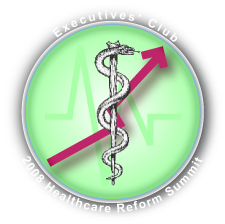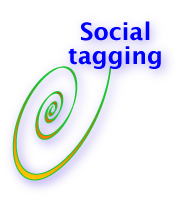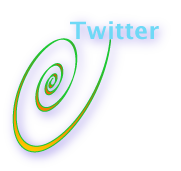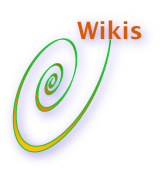“Yes,” Says Team of Healthcare Experts, Employer CEOs and Patient Representative at the Executives’ Club of Chicago, “But You Must Change Your Ways”
 Honestly Assessing Quality—Engaging Consumer Empowerment—Trading in the Ferrari for a Chevy Honestly Assessing Quality—Engaging Consumer Empowerment—Trading in the Ferrari for a Chevy
The Executives’ Club of Chicago convened its healthcare reform summit at the Hilton Chicago on 20 February 2008, drawing on diverse expertise. Ian Morrison, Ph.D., healthcare futurist, gave the keynote and moderated two panels: first, the healthcare expertise panel with Dean Harrison, CEO Northwestern Memorial Healthcare; William Novelli, CEO AARP; Scott P. Serota, CEO BlueCross BlueShield Association; and second, the business executive panel with Andrew M. Appel, Chairman AON Consulting; John A. Edwardson, CEO, CDW; John B. Menzer, Vice Chairman and Administrative Officer, Wal-Mart Stores. Robert L. Parkinson, CEO, Baxter Healthcare gave an insightful point of view on recommended actions to close the event.
There was broad agreement that the U.S. healthcare system was broken, and speakers offered excellent insights and perspectives about how to fix the system. However, what they didn’t say was as interesting as what they did, and I will address two key issues in […]
India Trade Minister Draws Chicago-India Parallels at Executives’ Club offers coverage of Shri Kamal Nath’s Chicago presentation. Key themes: new global economic architecture presages economic realignment and thinking beyond the obvious to tap emerging opportunities.
 Illinois leaders were addressed by His Excellency Shri Kamal Nath, Minister of Commerce and Industry, Republic of India. True to form, His Excellency struck chords of transformation, partnership, common interests and harmony at the lunch held in his honor at the University Club on 19 February 2008. Attending were Chicago Mayor Richard M. Daley, Mr. Rajinder Bedi, Managing Director of the Illinois Office of Trade and Investment, The Honorable Susan Schwab, U.S. Trade Representative, Craig S. Donohue, Chief Executive Officer, CME Group and John Estey, President & Chief Executive Officer, SC Electric Company. Illinois leaders were addressed by His Excellency Shri Kamal Nath, Minister of Commerce and Industry, Republic of India. True to form, His Excellency struck chords of transformation, partnership, common interests and harmony at the lunch held in his honor at the University Club on 19 February 2008. Attending were Chicago Mayor Richard M. Daley, Mr. Rajinder Bedi, Managing Director of the Illinois Office of Trade and Investment, The Honorable Susan Schwab, U.S. Trade Representative, Craig S. Donohue, Chief Executive Officer, CME Group and John Estey, President & Chief Executive Officer, SC Electric Company.
Reading between the lines, the U.S. and India stand at a significant turning point: India’s impressive economic growth is a significant element of the ongoing redistribution of global economic power—which holds excellent opportunities for U.S. businesses and workers that are looking for it.
[…]
 Time-pressed executives must always think about what they are getting from their work as well as what a proposed situation (job, board of directorship, volunteer position) will cost in terms of time, energy and aggravation. All jobs are increasingly collaborative, so when you understand how to use LinkedIn for due diligence, you will go farther and endure less aggravation at the hands of future colleagues. Time-pressed executives must always think about what they are getting from their work as well as what a proposed situation (job, board of directorship, volunteer position) will cost in terms of time, energy and aggravation. All jobs are increasingly collaborative, so when you understand how to use LinkedIn for due diligence, you will go farther and endure less aggravation at the hands of future colleagues.
LinkedIn is an excellent reference checking tool, so here I will give you the quick run-down and refer you to a hilarious-for-some post by Guy Kawasaki for additional detail.
[…]
 Many a CMO, CTO and CIO is asking him/herself when, how and why they should introduce social networking to the enterprise and, unlike startups and consumers, they must contemplate how these emerging phenomena fit with the corporate universe of technology and business processes. Critical to the enterprise adoption calculus is guessing how prevalent new technologies, processes and habits will be, so here is a back-of-the-envelope look at how social networks might look three years in the future. Many a CMO, CTO and CIO is asking him/herself when, how and why they should introduce social networking to the enterprise and, unlike startups and consumers, they must contemplate how these emerging phenomena fit with the corporate universe of technology and business processes. Critical to the enterprise adoption calculus is guessing how prevalent new technologies, processes and habits will be, so here is a back-of-the-envelope look at how social networks might look three years in the future.
[…]
 This article will explain something that’s probably been nagging at you for some time: what in the world are all these little icons that seem to be popping up everywhere? This article will explain something that’s probably been nagging at you for some time: what in the world are all these little icons that seem to be popping up everywhere?

These little icons take you to various social tagging and bookmarking systems, which are an exceptionally powerful Web 2.0 phenomenon that is under the radar in 2008 but has immense potential for enterprises and individuals. Emerging social tagging solutions offer marketers an excellent means to enable customers to help each other and improve a wide range of Website metrics. The most well known tagging/bookmarking sites are B2C: Del.icio.us, Furl, Netvous, Bluedot and Ma.gnolia, but tagging has a solid B2B value proposition as well.
[…]
 LinkedIn and other social networks are often hard for executives to get their mental arms around—precisely because business and government have had linear structures, which function very differently than network structures. Reflect on many of the metaphors and concepts on which we depend: supply chains, production lines, value chains, hierarchies: even the notion of a process is usually linear. Our habit of thinking linearly makes networks difficult to deal with, conceptually and practically. LinkedIn and other social networks are often hard for executives to get their mental arms around—precisely because business and government have had linear structures, which function very differently than network structures. Reflect on many of the metaphors and concepts on which we depend: supply chains, production lines, value chains, hierarchies: even the notion of a process is usually linear. Our habit of thinking linearly makes networks difficult to deal with, conceptually and practically.
However, society is morphing from linear to networked patterns in almost all dimensions, and, although LinkedIn and other social networks reduce transaction costs, they don’t save us from having to deal with networks. It’s also interesting that the world, say, biological systems, exhibits networked patterns, and humans’ communication and business patterns are just starting to get in synch with that. If we want to be more effective and secure in this environment, the question of the moment is, “How do we make networks work for us?”
[…]
 Twitter is a relatively new Web 2.0 phenomenon that is blazing a new category, which some people term “microblogging,” because all Twitter posts are limited to 140 characters, and twittering is reporting. Twittering can be done via a plain old cell phone via text (SMS) messaging, via a web browser or via a smartphone, and it is chiefly a broadcast activity: twitterers push SMS messages out to their networks. Twitter is a relatively new Web 2.0 phenomenon that is blazing a new category, which some people term “microblogging,” because all Twitter posts are limited to 140 characters, and twittering is reporting. Twittering can be done via a plain old cell phone via text (SMS) messaging, via a web browser or via a smartphone, and it is chiefly a broadcast activity: twitterers push SMS messages out to their networks.
Like most things Web 2.0, Twitter began within the B2C, pop culture context, but I predict that it will become a staple for enterprises by 2010. Twitter is very transformational, and it holds significant disruptive potential for business processes. Here I will outline its use for forward-thinking CMOs, CEOs, CIOs and other executives.
[…]
 Wikis are one of Web 2.0’s most secret weapons as of this writing, and they will transform the metrics around administration and communication. They are “leicht,” as Germans say. Deceptively simple. Sublime. Wikis are one of Web 2.0’s most secret weapons as of this writing, and they will transform the metrics around administration and communication. They are “leicht,” as Germans say. Deceptively simple. Sublime.
Wikis are collective desktops that enable teams to collaborate much more efficiently than they do now. Gone are myriad versions of locally (on your computer) stored spreadsheets, presentations and documents that team members shuffle around via legacy email, fax, phone and sneakernet. Legacy project management is terrifically inefficient, and wikis enable their complete reengineering by maximizing the power of asynchronous communication (not concurrent, like a face to face conversation). Here’s how they work.
[…]
 LinkedIn tries to curb the natural human competitive instinct by capping the number of contacts displayed at 500, so people who like to achieve high numbers had to create their own sites. Many people wonder how it’s possible to manage large networks, so here I will address that briefly. LinkedIn tries to curb the natural human competitive instinct by capping the number of contacts displayed at 500, so people who like to achieve high numbers had to create their own sites. Many people wonder how it’s possible to manage large networks, so here I will address that briefly.
The organizing principle that drives activity in LinkedIn or other networks is, “What’s the point, what am I trying to accomplish?” Without some kind of intention, large numbers of contacts are essentially data and nothing more. They could be evolved to higher value relationships, but that takes work, and no one has the kind of time to deal with such a huge network.
[…]
 Everything You Wanted to Know about Web 2.0: Blogs concisely explains blogs’ value proposition for businesses and executives. Everything You Wanted to Know about Web 2.0: Blogs concisely explains blogs’ value proposition for businesses and executives.
Probably the most pervasive Web 2.0 tool out there is the weblog or “blog.” Blogs have a personal element to them and reflect the personal element of Web 2.0, which is at root about P2P (person to person) communication and connections. Blogs are a powerful way to share what things are important to you.. and to your stakeholders, whether they are boards of directors, prospective employers, partners or prospective employees.
As you can see from the Google Trends profile below right, references to “blog” have steadily grown since 2004, but many executives are unfamiliar with what blogs are exactly, how they work and what they’re good for. The EGLI Guides Series will briefly define blogs from a business and marketing context, explain how you can use them and share a few enterprise blog vendors.
[…]
|
|
 Honestly Assessing Quality—Engaging Consumer Empowerment—Trading in the Ferrari for a Chevy
Honestly Assessing Quality—Engaging Consumer Empowerment—Trading in the Ferrari for a Chevy
 Illinois leaders were addressed by His Excellency Shri Kamal Nath, Minister of Commerce and Industry, Republic of India. True to form, His Excellency struck chords of transformation, partnership, common interests and harmony at the lunch held in his honor at the University Club on 19 February 2008. Attending were Chicago Mayor Richard M. Daley, Mr. Rajinder Bedi, Managing Director of the Illinois Office of Trade and Investment, The Honorable Susan Schwab, U.S. Trade Representative, Craig S. Donohue, Chief Executive Officer, CME Group and John Estey, President & Chief Executive Officer, SC Electric Company.
Illinois leaders were addressed by His Excellency Shri Kamal Nath, Minister of Commerce and Industry, Republic of India. True to form, His Excellency struck chords of transformation, partnership, common interests and harmony at the lunch held in his honor at the University Club on 19 February 2008. Attending were Chicago Mayor Richard M. Daley, Mr. Rajinder Bedi, Managing Director of the Illinois Office of Trade and Investment, The Honorable Susan Schwab, U.S. Trade Representative, Craig S. Donohue, Chief Executive Officer, CME Group and John Estey, President & Chief Executive Officer, SC Electric Company. Time-pressed executives must always think about what they are getting from their work as well as what a proposed situation (job, board of directorship, volunteer position) will cost in terms of time, energy and aggravation. All jobs are increasingly collaborative, so when you understand how to use LinkedIn for due diligence, you will go farther and endure less aggravation at the hands of future colleagues.
Time-pressed executives must always think about what they are getting from their work as well as what a proposed situation (job, board of directorship, volunteer position) will cost in terms of time, energy and aggravation. All jobs are increasingly collaborative, so when you understand how to use LinkedIn for due diligence, you will go farther and endure less aggravation at the hands of future colleagues. Many a CMO, CTO and CIO is asking him/herself when, how and why they should introduce social networking to the enterprise and, unlike startups and consumers, they must contemplate how these emerging phenomena fit with the corporate universe of technology and business processes. Critical to the enterprise adoption calculus is guessing how prevalent new technologies, processes and habits will be, so here is a back-of-the-envelope look at how social networks might look three years in the future.
Many a CMO, CTO and CIO is asking him/herself when, how and why they should introduce social networking to the enterprise and, unlike startups and consumers, they must contemplate how these emerging phenomena fit with the corporate universe of technology and business processes. Critical to the enterprise adoption calculus is guessing how prevalent new technologies, processes and habits will be, so here is a back-of-the-envelope look at how social networks might look three years in the future. This article will explain something that’s probably been nagging at you for some time: what in the world are all these little icons that seem to be popping up everywhere?
This article will explain something that’s probably been nagging at you for some time: what in the world are all these little icons that seem to be popping up everywhere? Twitter is a relatively new Web 2.0 phenomenon that is blazing a new category, which some people term “microblogging,” because all Twitter posts are limited to 140 characters, and twittering is reporting. Twittering can be done via a plain old cell phone via text (SMS) messaging, via a web browser or via a smartphone, and it is chiefly a broadcast activity: twitterers push SMS messages out to their networks.
Twitter is a relatively new Web 2.0 phenomenon that is blazing a new category, which some people term “microblogging,” because all Twitter posts are limited to 140 characters, and twittering is reporting. Twittering can be done via a plain old cell phone via text (SMS) messaging, via a web browser or via a smartphone, and it is chiefly a broadcast activity: twitterers push SMS messages out to their networks. Wikis are one of Web 2.0’s most secret weapons as of this writing, and they will transform the metrics around administration and communication. They are “leicht,” as Germans say. Deceptively simple. Sublime.
Wikis are one of Web 2.0’s most secret weapons as of this writing, and they will transform the metrics around administration and communication. They are “leicht,” as Germans say. Deceptively simple. Sublime. Everything You Wanted to Know about Web 2.0: Blogs concisely explains blogs’ value proposition for businesses and executives.
Everything You Wanted to Know about Web 2.0: Blogs concisely explains blogs’ value proposition for businesses and executives.